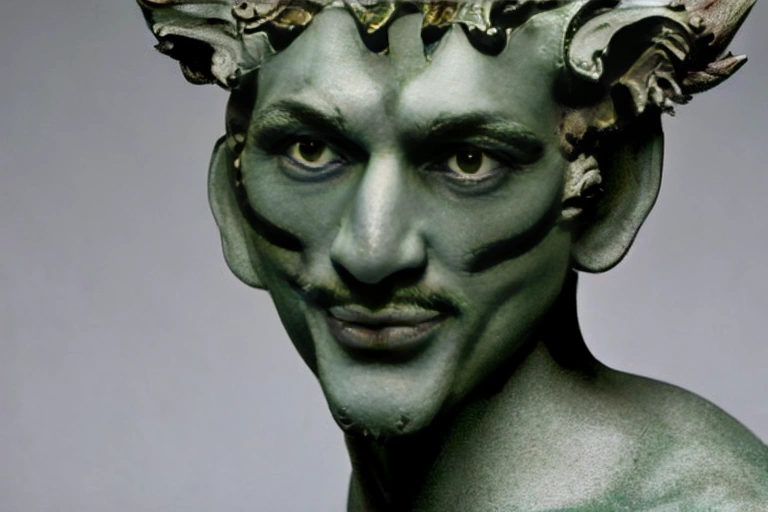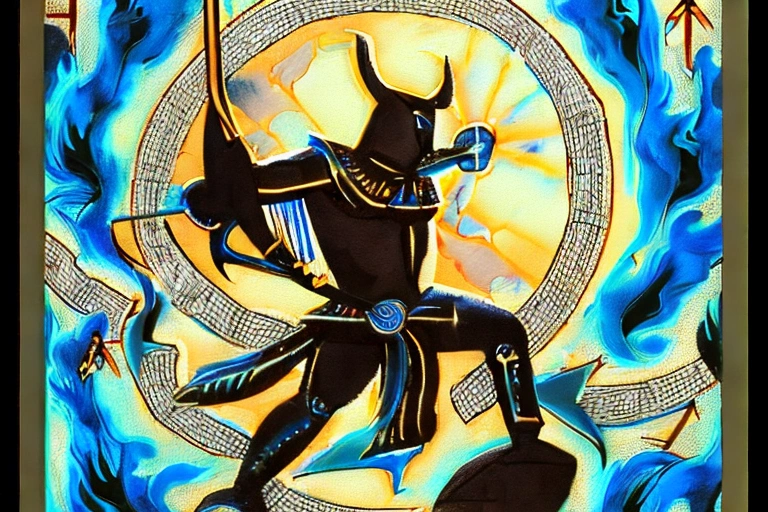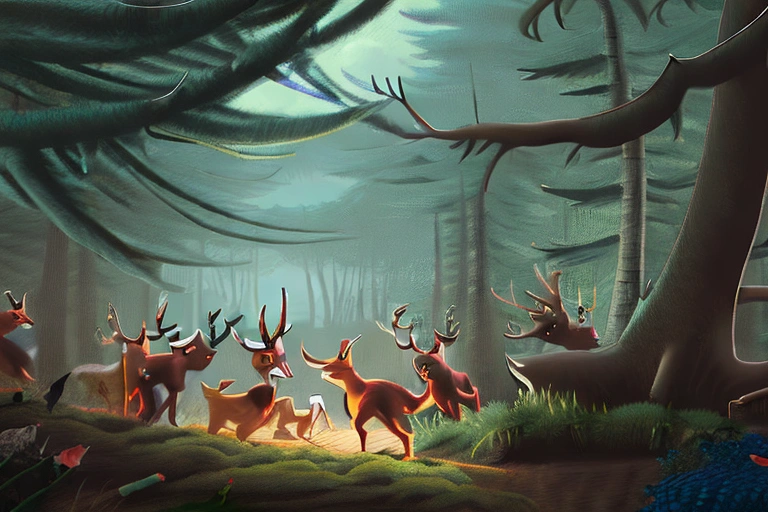A satyr and his muse: the erotic between man and nature
What is the connection between a satyr and his muse? What is the meaning of their erotic relationship when it comes to man and nature? This blog post seeks to answer those questions, diving into the complex relationship between mythological creatures and humans. Read on to find out what this enthralling connection can tell us about our relationship with the natural world.

The Origins of Satyrs
Ancient Greeks considered satyrs to be half-man, half-animal. Referred to as the “erotic between man and nature,” satyrs were often portrayed as innocent creatures who enjoyed being wild and carefree. The mythical creature was believed to have originated from the gardens of Dionysus, the god of wine and celebration. Satyrs were thought to be clever pranksters who delighted in fooling humans with their playful antics. They often sported forestry or pottery skills, which they used to create beautiful pieces that adorned the abodes of their gods. In depictions, they are usually depicted with goat heads, ears, tails and hooves; they also often wore horns on their heads or carried lassos in their hands.

The Mythology of Satyrs
The mythological creature known as a satyr is typically portrayed as horned, goat-like creatures sporting flowery skirts and reveling in the natural world. In some cases, they are even associated with Dionysus, the god of wine and dance.
Satyrs have often been associated with the erotic nature of man and nature, which has led to them being used symbolically in various works of art. For example, Michelangelo’s sixteen bronze statues of The Rape of Europa represent Europe being carried off by Jupiter (the Roman God), who is accompanied by four satyrs carrying her across his shoulders. Similarly, Diego Velázquez’s painting Las Meninas features a group of children playing near a donkey that has been turned into a Satyr thanks to an artist’s brush.

The Erotic Representation of Satyrs
Satyrs are depicted as half-man, half-goat creatures with long hair and horns. They are known for their eroticism and frequently engage in sexual activity with nymphs or other female forest spirits. In some cases, they represent the wild side of man, while in others they are considered symbols of mischief and divert attention away from more serious matters.

The Relationship Between Man and Nature
Satyrs are often associated with the erotic, and their relationship with nature is often seen as a metaphor for the relationship between man and woman. The satyr is often depicted as being in touch with his wild side, and his muse is often seen as being a representation of nature itself. This connection between man and nature is often seen as being something that is both beautiful and dangerous.

Exploring the Duality of Satyrs
Satyrs are usually associated with the erotic in Greek mythology. They are half-man, half-goat creatures who enjoy a carefree life of pleasure and fun. However, there is also a side to these creatures that is dark and can be quite dangerous.
The duality of satyrs provides an interesting perspective on the nature-versus-nurture debate. These creatures were born out of a mutual love between man and nature. However, their wild sides were often caused by outside forces such as temptations or violence. In other words, the duality of satyrs shows that it is not always easy to find balance between man and nature.
The Influence of Satyrs in Art and Literature
The Satyr’s Longing for Nature
The satyr is often seen as a creature of the forest, roaming free and in harmony with nature. This is in stark contrast to the modern image of the satyr, which is often associated with lewd and debauched behavior. However, there is a long history of the satyr being seen as a symbol of eroticism and nature’s power.
The first reference to the satyr as a symbol of eroticism comes from the ancient Greeks. The god Dionysus was known as the god of wine and fertility, but he was also known as the god of eroticism and pleasure. One of his most famous followers was the satyr Silenus, who was depicted as a drunken and lecherous creature. Silenus was often depicted with a wine jug in his hand, symbolizing his love of drink and pleasure.
The ancient Romans also saw the satyr as a symbol of eroticism. One of the most famous examples of this is the statue of the Satyr Marsyas, which is located in the Roman Forum. Marsyas was a satyr who was punished by Apollo for daring to challenge him. Apollo transformed Marsyas into a music tree, where he sang for the pleasure of the gods. The statue of Marsyas is often seen as a symbol of eroticism and sensuality.
The satyr’s longing for nature is also evident in his literature and art. One of the most famous examples of this is the poem The Satyr’s Song, which is written by the Greek poet Pindar. The poem is about the satyr Silenus, who longs for the company of the nymphs. Silenus is depicted as a lonely and longing creature, who yearns for the wildness and power of nature.
The satyr’s influence can be seen in many different forms of art and literature. He is often seen as a symbol of eroticism and nature’s power, which is evident in his literature and art.
The Power of Nature’s Allure
Satyrs have always been something of an enigma to us. They are creatures that represent both the beauty and terror of nature, embodying the duality that is so intrinsically tied within our species. Yet despite their seemingly conflicting natures, there is a deep-seated link between man and satyr that has been perpetuated through art and literature for centuries.
For many artists, including Michelangelo, Da Vinci, and Toulouse-Lautrec, the satyr was a muse par excellence; inspiring them to create some of the most iconic works in history. In these paintings and sculptures, you can see how man’s fascination with the natural world leads him down a darkpath of lust and violence – but it’s also a pathway to beauty and enlightenment.
The power of nature’s allure is something that has always been at the heart of satyr mythology. In Greek and Roman mythology, for example, the satyr was a creature that represented the wild side of nature – the untamed, untamable side that is often seen as chaotic and dangerous. But in the same way that this side of nature can be beautiful and inspiring, it can also be destructive and deadly.
This duality is something that we see reflected in modern day culture too. On the one hand, we have people who are fascinated by the natural world and want to learn as much as they can about it. On the other hand, there are those who are drawn to the dark side of nature, wanting to experience the power and chaos that it can offer.
The influence of satyrs in art and literature is undeniable. They are a symbol of both the beauty and terror of nature, and their duality is something that we can all relate to.
The Intimate Connection between Man and Nature
The erotic nature of the satyr is well-known and often celebrated in art and literature. However, this isn’t always the case. In ancient Greece, it was thought that satyrs were half-man, half-goat. This duality was thought to reside within all people, and it was through their interactions with nature that they could unlock their true potential. Through the act of lovemaking, man can connect with his inner nature, which is often depicted as wild and free.
This idea of oneness with nature also pervades in modern times through artists like David Lynch who appreciate how music can be understood as an unbroken thread from creation to destruction. These are just a few examples illustrating how the intimate connection between man and nature is still very much alive and well.
The Mythology of the Satyr and His Muse
The satyr is one of the most popular and iconic creatures in classical mythology. He is often depicted as a muscle-bound, horned man with goat-like features and a leering disposition. The satyrs are typically associated with nature, pleasure, and love, and their activities reflect these themes.
The mythology of the satyr and his muse is rich and complex. In general, the Muse represents inspiration or creativity, while the Satyr represents physicality and unrestrained passion. They are often seen as complementary figures who feed off each other’s energy.
Their relationship can be considered erotic in nature. The Satyr desires freedom from social conventions and restrictions, while the Muse offers limitless opportunity for self-expression. Their union is often seen as a symbol of liberation and self-fulfillment.
The satyr is an important figure in art and literature. He is often used to symbolize physicality and unrestrained passion, and his relationship with the Muse is often seen as erotic in nature.
Ancient Representations of Satyrs
The Primal Bond of Man and Nature
Satyrs were a popular figure in Greco-Roman mythology, often depicted as playful and carefree creatures that roamed the forests and hillsides. But beneath the surface was an undercurrent of eroticism and indulgence – something that resonated with many people in antiquity.
The association between man and nature was perhaps at its strongest when it came to the relationship between satyrs and muse. In many cases, the muse was seen as a wild creature that could captivate any man she pleased (as exemplified by Pygmalion’s sculpture of Eriphyle). The satyr, meanwhile, represented both the sensual side of man and his connection to nature. In some depictions, he would be shown clad only in a skin-tight loincloth, his body glittering with sweat and a lustful glint in his eye.
The primal bond between man and nature was something that many people found both sexually exciting and spirituallyful. And it’s this link, which remains central to our understanding of satyrs today, that makes them one of the most enduring figures in Greco-Roman mythology.
The Art of Erotic Ecstasy
The ancient Romans were notorious for their love of all things sexual, and the satyr was no exception. A creature with horns and a goat’s body, the satyr was often depicted alongside his muse – a nymph or female nature spirit who inspired him to lyrical poetry and dance. The art of erotic ecstasy is widely associated with the satyrs, as they are often shown engaging in explicit acts of lovemaking. Their sexuality is simultaneously primal and sophisticated, indicative of the universality of human lust.
Exploring the Mythology of Satyrs and Muses
According to Greek mythology, satyrs are wild and lustful horse-like creatures that roam the forests and meadows of Mount Cyllene. Satyrs are often depicted as artists or musicians, because their natural love of music and dancing is said to be so powerful. It is also thought that they were guardians of the forest, because they were able to move between the earthly and spiritual worlds.
One well-known example of a satyr is Aristophanes’ playwright Dionysus, who is usually portrayed as a drunken reveler. In this play, Dionysus desires Leto (the mother goddess), but when she resists him he tricks her into drinking from the sacred spring of Cydonius. As Leto drinks she becomes a satyr, and Dionysus is able to have intercourse with her. This story is also used as the basis for the opera Der Freischütz by Richard Wagner.
The mythology of satyrs and their muse is often associated with sexuality, because the creatures are said to be wild and lustful. In some cases, the muse may be one of Dionysus’ followers who helps him control his wild side. Other times, the muse may be a nature goddess or spirit who inspires artists and musicians.

Themes of Lust and Pleasure in Satyr Mythology
In ancient Greek mythology, the satyr is a half-man, half-horse creature that is often depicted as being strongly sexual and frivolous. They are creatures of nature who represent the wild side of life and are known for their happy temperament and lustful dispositions. The erotic between man and nature is at the heart of many satyr myths, which explore the power dynamics inherent in relationships between equals.
One such story tells of how Dionysus became infatuated with Maia, a nymph who lived on Mount Nysa. When Dionysus discovered her he pursued her relentlessly until she finally agreed to be his mate. In keeping with their natural urges, they enjoyed unrestrained sex onMount Nysa – an experience that ultimately led to the conception of Zagreus (the god of wine). Another popular myth tells of Pyreneus and Calliope, two mountain nymphs who were also possessed by Dionysus. After drinking from Pyrenees’ springtime font, he fell deeply in love with her; however she refused to reciprocate his affections because she was already wed to Arion, a son of Neptune. In order to win her over, Dionysus transformed himself into a chariot drawn by bulls and attempted to run them down while they were spend time together under the mistletoe at Calliope’s shrine. When Arion realized what was happening he jumped out of the way just in time – but not before Calliope had been swept away by Dionysus’ bull team! In both cases it was through sexualizing natural phenomena (mountains and springs) that these creatures gained access to human hearts and bodies.
This example demonstrates how even seemingly innocent stories can contain elements that speak volumes about our culture’s attitudes towards sexuality and pleasure. By taking things slow, lettingnature take its course, and playingfully challenging established laws & norms ,Satyrs & Muses demonstrate that there’s nothing too wild or outrageous about exploring your deepest desires – all while having plentyof fun along the way!

Gender Dynamics in the Mythology of Satyrs
Satyrs are often depicted as being in a sexual relationship with nymphs, who are often depicted as being in a romantic relationship with gods or other male figures. This erotic dynamic is often seen as a representation of the power dynamics between men and women. In some cases, the satyr may be seen as representing male sexuality in its purest form, while the nymph represents female sexuality in its most unrestrained form.

Representations of Nature in Ancient Greek Art
The ancient Greeks were a people who loved nature and the natural world. This is evident in their mythology, which features a wide variety of representations of nature. Some of these representations are humorous, while others are more serious.
One of the most famous representations of nature in ancient Greek art is the Satyr and Muse. This painting is often cited as an example of the erotic between man and nature. The Satyr is depicted as being passionately in love with the Muse, who is sitting at his side. The painting is often seen as a symbol of the creative power of nature.

Understanding the Power Dynamics Between Man and Nature
Exploring the Mythology of Satyrs
The mythology of satyrs is one that is full of sexual tension and exploration. Satyrs are half-man, half-goat creatures who are known for their libidinous natures. They are often depicted as being playful and carefree, but can also be fiercely protective of those they love.
One of the most famous depictions of a satyr is from the painting The Birth of Venus by Botticelli. In this painting, we see a beautiful woman lying in bed with a satyr looming over her. The satyr is clearly in control, and his gaze is full of desire. This painting is a perfect example of the power dynamics between man and nature. The woman is clearly in charge, and she is using her sexuality to attract and dominate the satyr.
The Erotic Power of Nature
The power dynamics between man and nature are at the heart of much philosophical and poetic discourse. In art, these dynamics can be explored through representations of both natural and supra-natural entities. Some ancient Greeks used satyrs (half-man, half-fairy creatures) as a figure for this sort of discussion.
Satyrs were often depicted in situations where they were intimately connected to female nymphs or goddesses. These depictions serve as an example of how the erotic power of nature could be used to create beautiful images that appealed to both the viewer’s emotions and intellect. The beauty of these images was not just superficial; it was also rooted in their power to evoke feelings of love and reverence in those who saw them.
The Symbiotic Relationship Between Man and Nature
The satyr is a versatile figure in Greek art, representing both nature and the erotic between man and nature. He is often seen as a half-man, half-animal, embodying all that is wild and untamed. The muse is typically depicted as either beautiful or seductive, helping to drive the satyr towards new artistic endeavors. While the relationship between man and nature can be viewed in many ways, it can be said that the power dynamics between them are mutually beneficial. In this way, their relationship perpetuates itself through creation.
Examining the Role of the Muse in Satyr Mythology
The satyr is a creature that is often associated with the erotic between man and nature. This is due to the fact that satyrs are often depicted as being half-man, half-goat. They are also known for their sexual exploits, which often involve them seducing nymphs or maidens. This is in contrast to the more peaceful aspects of the satyr’s mythology, which includes him being a companion to Dionysus.
The role of the muse in satyr mythology is often overlooked. She is often depicted as being very beautiful and graceful. She is also known for being very flirtatious, which can lead to her being seduced by the satyr. In some cases, she may even join him in his sexual escapades. The muse is often seen as being very powerful, which is why she is able to tempt the satyr away from his more peaceful aspects of his mythology.

The Role of Satyrs in Modern Culture
Satyrs have long been associated with the erotic, and their mythology reflects this. They are often depicted as half-man, half-animal, and their muse is often a nymph or a faun. In some cases, the satyr is also associated with the god Dionysus.
Today, satyrs are often used as a symbol for the free and wild side of human nature. They are often used in advertising to represent the fun and excitement that can be found in life.
In conclusion, the mythology of satyrs is an incredibly rich and varied source of exploration. It reveals a deep understanding of the power dynamics between man and nature, as well as a complex representation of gender roles and eroticism. Satyrs have been represented in various ways throughout history, from ancient Greek art to modern culture, and their influence is still felt today. We hope this article has helped to shed light on the multifaceted mythology of satyrs. For more content on mythology and ancient art, be sure to check out our other articles!

Shoptimizer Blog
Meditation williamsburg kogi blog bushwick pitchfork polaroid austin dreamcatcher narwhal taxidermy tofu gentrify aesthetic.
Humblebrag ramps knausgaard celiac, trust fund mustache. Ennui man braid lyft synth direct trade.


